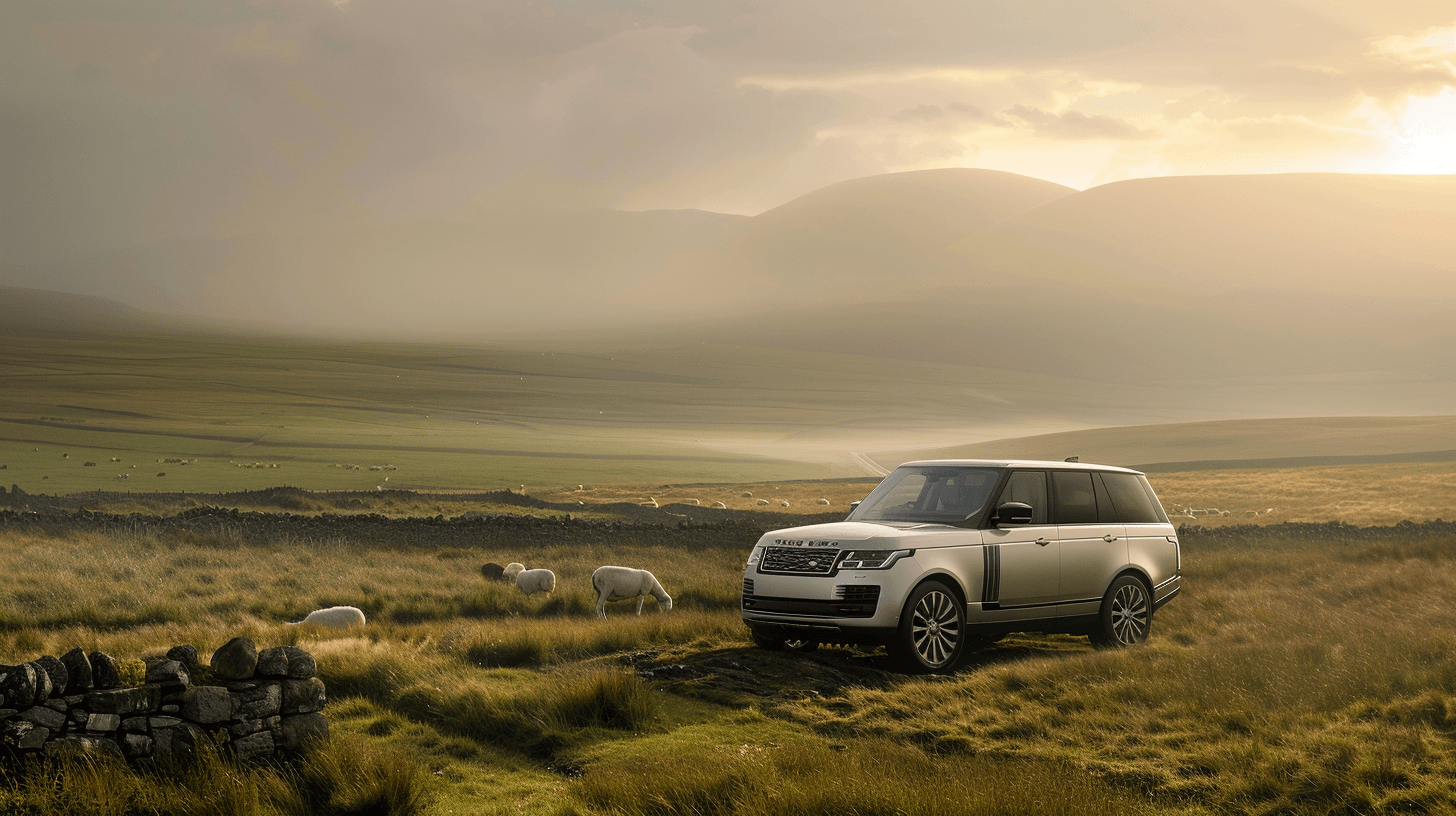Over five decades ago, the Range Rover revolutionized the automotive world by creating an entirely new category—the luxury SUV. This groundbreaking vehicle emerged from Land Rover’s vision to bridge the gap between rugged off-road capability and sophisticated on-road comfort, forever changing how consumers viewed utility vehicles. The Range Rover’s pioneering design became the first vehicle ever displayed at the prestigious Louvre, cementing its status as both automotive excellence and cultural icon.
The Range Rover transformed the automotive landscape by pioneering the luxury SUV category over 50 years ago. Originally envisioned by Charles Spencer "Spen" King, it combines rugged performance with refined comfort. Under various ownerships, including Tata Motors, the brand has embraced innovation, maintaining its core philosophy while incorporating advanced technologies. Range Rover continues to thrive as a cultural icon, appealing to affluent consumers through its legacy of quality, exclusivity, and adaptability to modern luxury demands.
From its origins under British Leyland to its evolution through BMW ownership and finally to Tata Motors’ Jaguar Land Rover division, the Range Rover has maintained its core philosophy of harmonizing capability with luxury. Each ownership transition brought technological advancement while preserving the heritage established by original designer Spen King. The brand’s commitment to innovation continues today, with Range Rover models featuring cutting-edge infotainment systems, advanced driver assistance technology, and Terrain Response capabilities that ensure smooth performance across any terrain—from city streets to challenging off-road environments.
Table of Contents
The Origins and Evolution of a Luxury Icon
The Range Rover’s transformation from concept to cultural phenomenon represents one of automotive history’s most significant paradigm shifts. This evolution chronicles how British engineering excellence created an entirely new vehicle category that redefined luxury transportation standards.
From Utility to Luxury Pioneer
Charles Spencer “Spen” King’s vision in the late 1960s addressed a fundamental gap between rugged Land Rovers and comfortable passenger cars. Working for the Rover Company, King recognized that affluent buyers desired vehicles capable of traversing challenging terrain without sacrificing refinement. His concept challenged established automotive conventions by proposing a vehicle that could excel both on Mayfair streets and Scottish highlands.
The prototype development phase revealed King’s methodical approach to Range Rover luxury positioning. Engineers conducted extensive testing across diverse terrains, from Welsh mountains to African savannas, ensuring the vehicle met rigorous performance standards. This comprehensive evaluation process established the foundation for Range Rover brand identity that persists today.
The original 1970 model featured innovations that distinguished it from existing utility vehicles. Permanent four-wheel drive eliminated the need for manual engagement, while coil spring suspension replaced traditional leaf springs. These engineering advances created a smoother ride quality previously unavailable in off-road capable vehicles. The aluminum V8 engine provided sufficient power for highway cruising while maintaining fuel efficiency standards acceptable to luxury car buyers.
Range Rover marketing strategy from launch emphasized capability over comfort, initially targeting farmers, estate owners, and outdoor enthusiasts. Early advertisements showcased the vehicle’s ability to climb steep inclines and ford streams, positioning it as the ultimate tool for rural landowners. This utilitarian approach gradually evolved as urban buyers discovered the Range Rover’s appeal as a status symbol vehicles.
The vehicle’s design philosophy balanced functional requirements with aesthetic considerations. Clean lines and minimal ornamentation reflected British design principles, while practical features like removable rear seats and washable interior surfaces acknowledged its working vehicle heritage. This dual-purpose design became central to Range Rover global branding efforts, appealing to buyers who valued both capability and sophistication.
The Birth of the Ultimate All-Terrain Vehicle
Range Rover’s technical innovations established benchmarks that competitors struggled to match for decades. The vehicle’s permanent four-wheel drive system distributed power automatically between front and rear axles, eliminating driver intervention required by part-time systems. This technology provided superior traction on various surfaces while maintaining on-road handling characteristics comparable to luxury sedans.
The coil spring suspension system represented a radical departure from conventional off-road vehicle design. Traditional leaf springs, while robust, transmitted road imperfections directly to passengers. Range Rover’s independent front suspension and coil-sprung rear axle absorbed terrain irregularities, creating an elite driving experience previously unavailable in utility vehicles. This suspension technology became fundamental to the luxury car lifestyle the brand would later cultivate.
Engine selection reflected careful consideration of performance requirements and market expectations. The 3.5-liter aluminum V8, derived from Buick designs, provided 135 horsepower while weighing significantly less than comparable iron engines. This power-to-weight ratio enabled respectable acceleration and highway performance, addressing concerns that off-road vehicles couldn’t satisfy modern driving demands.
Interior appointments initially prioritized durability over luxury, featuring vinyl upholstery and rubber floor mats suitable for agricultural use. However, designers incorporated quality materials and attention to detail that distinguished the Range Rover from purely utilitarian vehicles. Dashboard layouts emphasized functionality while maintaining visual appeal, establishing design principles that would evolve into the automotive prestige branding the marque is known for today.
The vehicle’s cultural impact became apparent when the Louvre Museum displayed a Range Rover as an example of outstanding industrial design in 1971. This recognition validated King’s vision of creating a vehicle that transcended traditional automotive categories. The exhibition established Range Rover’s position as more than transportation, elevating it to the status of design icon worthy of artistic recognition.
Manufacturing quality reflected British automotive industry standards of the early 1970s, with hand-finished details and traditional craftsmanship techniques. Production numbers remained modest, reinforcing the vehicle’s exclusivity and contributing to its appeal among discerning buyers. This limited availability strategy became integral to lifestyle branding efforts that positioned Range Rover ownership as a mark of distinction rather than mere transportation necessity.
Building a Global Heritage Brand
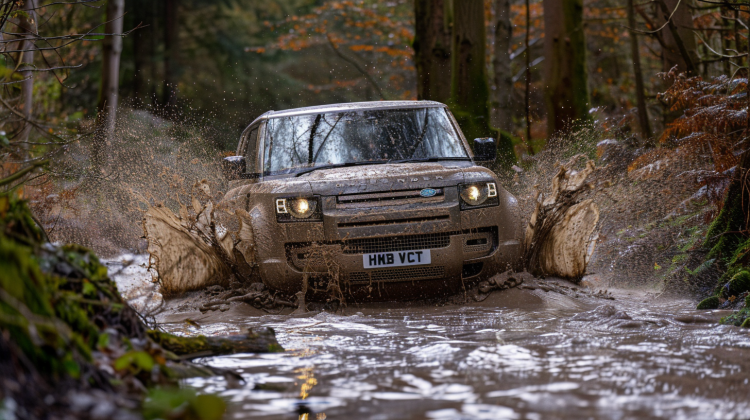
Range Rover’s transformation from a utilitarian off-road vehicle to a global luxury icon represents one of automotive history’s most successful brand evolutions. This metamorphosis established the foundation for what would become the world’s most recognizable premium SUV heritage.
Crafting the Premium SUV Identity
Range Rover’s brand identity emerged through deliberate positioning that distinguished it from traditional luxury sedans and basic utility vehicles. The brand established its premium SUV identity by integrating three fundamental elements that became its signature characteristics.
High-quality materials formed the cornerstone of Range Rover’s luxury positioning. Windsor leather interiors, natural wood veneers, and sustainable fabric selections created an atmosphere that rivaled traditional luxury saloons. These material choices reflected meticulous attention to detail that elevated the driving experience beyond mere transportation. The tactile quality of these elements communicated luxury through sensory engagement rather than ostentatious display.
Advanced technology integration separated Range Rover from conventional off-road vehicles. The introduction of sophisticated infotainment systems, driver assistance technologies, and the revolutionary Terrain Response system demonstrated the brand’s commitment to innovation. These technological advances enabled drivers to adapt vehicle performance to specific terrain conditions with unprecedented precision. The seamless integration of technology with traditional craftsmanship created a unique identity that appealed to both technology enthusiasts and luxury traditionalists.
Off-road capabilities remained central to Range Rover’s identity despite its luxury evolution. Permanent four-wheel drive systems and adaptive suspension technologies ensured authentic performance across diverse terrains. This capability differentiated Range Rover from luxury vehicles that prioritized comfort over functionality. The brand’s ability to deliver genuine off-road performance while maintaining on-road refinement became its defining characteristic.
The fusion of these elements created a distinctive brand identity that resonated with consumers seeking both capability and luxury. Range Rover’s marketing strategy emphasized this dual nature, positioning the vehicles as equally suitable for urban environments and remote adventures. This positioning attracted affluent consumers who valued versatility alongside prestige.
Brand identity development extended beyond product features to encompass lifestyle associations. Range Rover cultivated connections with outdoor activities, country estates, and sophisticated urban environments. These associations reinforced the brand’s appeal to consumers who identified with active, affluent lifestyles. The marketing strategy consistently portrayed Range Rover ownership as a reflection of personal success and adventurous spirit.
Royal Connections and Cultural Impact
Royal endorsement significantly elevated Range Rover’s cultural status and global brand recognition. In 1951, Land Rover received a Royal Warrant from King George VI, establishing a prestigious connection that continues to enhance the brand’s luxury credentials. This royal association provided immediate credibility and social validation that traditional marketing efforts couldn’t replicate.
The Royal Warrant represented more than ceremonial recognition; it demonstrated the royal family’s practical reliance on Land Rover vehicles. Members of the British Royal Family regularly used Range Rovers for official duties and personal transportation, creating authentic endorsements that resonated with luxury consumers worldwide. These genuine usage scenarios reinforced the brand’s reliability and suitability for discerning customers.
Royal connections extended beyond formal warrants to include regular public appearances. Range Rovers became synonymous with royal events, state occasions, and official ceremonies. Television coverage of these events consistently featured Range Rover vehicles, providing global exposure that money couldn’t purchase. The association with British heritage and royal tradition enhanced the brand’s prestige across international markets.
Cultural impact expanded through strategic placement in popular media and entertainment. Range Rover vehicles appeared in prestigious films, television series, and cultural events that reinforced their status as symbols of sophistication. The brand’s presence at high-profile sporting events, fashion shows, and cultural exhibitions further solidified its position within elite social circles.
The Louvre Museum’s display of a Range Rover as an example of exceptional design represented a cultural milestone that transcended automotive boundaries. This recognition positioned Range Rover alongside celebrated works of art and design, validating its aesthetic achievement. The exhibition demonstrated that Range Rover had achieved cultural significance beyond its functional purpose.
International recognition of Range Rover’s cultural importance manifested through awards, design accolades, and inclusion in prestigious collections. Museums and design institutions worldwide acknowledged Range Rover’s contribution to automotive design and cultural development. These recognitions reinforced the brand’s position as a cultural icon rather than merely a transportation option.
The brand’s cultural impact influenced lifestyle trends and social perceptions of luxury transportation. Range Rover ownership became associated with successful entrepreneurs, celebrities, and cultural influencers who valued both performance and prestige. This association created aspirational appeal that extended the brand’s influence beyond automotive enthusiasts to broader luxury consumers.
Contemporary cultural relevance remains strong as Range Rover continues to attract influential figures across entertainment, business, and sports. The brand’s ability to maintain cultural relevance across generations demonstrates its enduring appeal and successful brand evolution. Modern Range Rover marketing leverages this cultural heritage while appealing to contemporary luxury consumers who value authenticity and heritage alongside innovation.
Design Philosophy and Brand Values
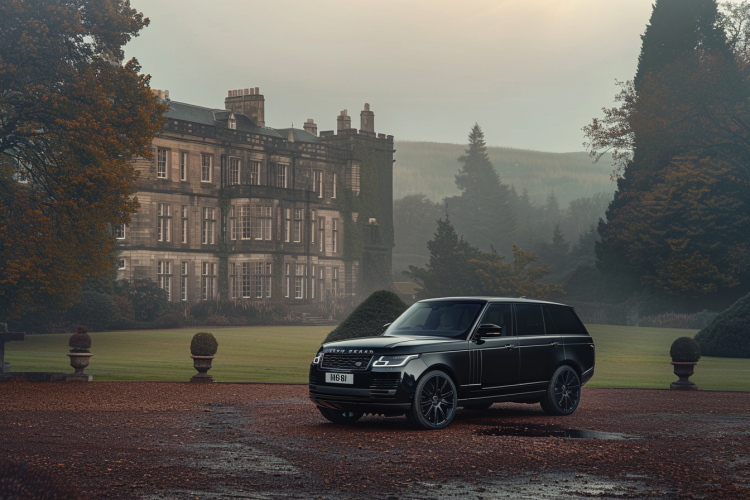
Range Rover’s design philosophy represents the perfect synthesis of rugged capability and refined luxury, establishing the foundation for its global branding strategy. This approach transcends mere aesthetics to embody a comprehensive lifestyle branding philosophy that resonates with affluent consumers worldwide.
Timeless Aesthetics and Modern Innovation
Range Rover’s aesthetic philosophy maintains its iconic boxy silhouette while incorporating contemporary design elements that ensure relevance across generations. The brand’s commitment to timeless aesthetics centers on clean lines, commanding proportions, and distinctive design cues that have remained consistent since 1970. This approach to Range Rover brand identity creates immediate recognition while avoiding the pitfalls of trend-driven design that quickly becomes outdated.
The integration of modern innovation within this classic framework demonstrates sophisticated Range Rover marketing strategy. Jaguar Land Rover’s investment in lightweight aluminum architecture reduces vehicle weight by approximately 420 kilograms compared to traditional steel construction, enhancing fuel efficiency without compromising the vehicle’s imposing presence. This technological advancement supports the brand’s environmental responsibility initiatives while maintaining the performance standards expected by luxury consumers.
Interior design philosophy emphasizes sustainable luxury through premium materials like Windsor leather and responsibly sourced natural woods. These elements create an atmosphere of refined sophistication that appeals to environmentally conscious luxury buyers. The use of sustainable fabrics alongside traditional luxury materials demonstrates how Range Rover luxury adapts to changing consumer values without sacrificing quality or comfort.
Advanced manufacturing techniques enable precise panel gaps and flawless paint finishes that reinforce the brand’s attention to detail. Each vehicle undergoes rigorous quality control processes that ensure consistency across all production facilities. This manufacturing philosophy supports Range Rover’s position as a status symbol vehicles by delivering products that meet the exacting standards of discerning customers.
The brand’s approach to modern innovation includes adaptive suspension systems, all-wheel steering technology, and electrified powertrains that enhance driving dynamics while preserving the classic Range Rover experience. These technological integrations demonstrate how the brand evolves without abandoning its core identity, ensuring continued relevance in the luxury automotive market.
Terrain Response and Performance Heritage
Range Rover’s Terrain Response system represents the cornerstone of its performance heritage, automatically adjusting vehicle settings to optimize capability across diverse driving conditions. This technology enables seamless transitions between mud, snow, sand, and rocky terrain while maintaining the luxury car lifestyle experience that defines the brand. The system’s sophistication reflects decades of off-road engineering expertise that originated with Land Rover’s military applications in the late 1940s.
The performance heritage encompasses permanent four-wheel drive technology that provides superior traction and stability across all driving environments. This capability differentiates Range Rover from luxury competitors by delivering genuine off-road performance rather than merely aesthetic appeal. The brand’s commitment to maintaining this capability ensures authenticity in its luxury positioning while supporting its reputation among outdoor enthusiasts and urban professionals alike.
Automotive prestige branding benefits significantly from Range Rover’s proven performance credentials in challenging environments. The vehicle’s ability to traverse extreme terrain while providing exceptional comfort reinforces its status as the ultimate elite driving experience. This dual capability appeals to consumers who value both luxury amenities and practical versatility, expanding the brand’s market appeal beyond traditional luxury segments.
Engineering heritage includes innovations like electronic air suspension that adjusts ride height based on driving conditions and terrain requirements. This technology enables the vehicle to maintain ground clearance for off-road capability while lowering for improved aerodynamics and fuel efficiency on highways. Such engineering solutions demonstrate how Range Rover integrates performance with luxury without compromise.
The brand’s performance philosophy extends to powertrain development, with modern engines delivering substantial power while meeting stringent emissions standards. Hybrid and electric variants maintain the brand’s performance credentials while addressing environmental concerns. This evolution ensures Range Rover’s continued relevance as governments worldwide implement stricter environmental regulations, protecting the brand’s long-term viability in global markets.
Range Rover’s performance heritage also encompasses its role as the Range Rover Royalty Favorite, with members of the British Royal Family regularly using these vehicles for official duties and personal transportation. This association reinforces the brand’s credibility and performance reliability while enhancing its prestige among global consumers who value royal endorsements and traditional British quality standards.
Manufacturing Excellence and Global Presence
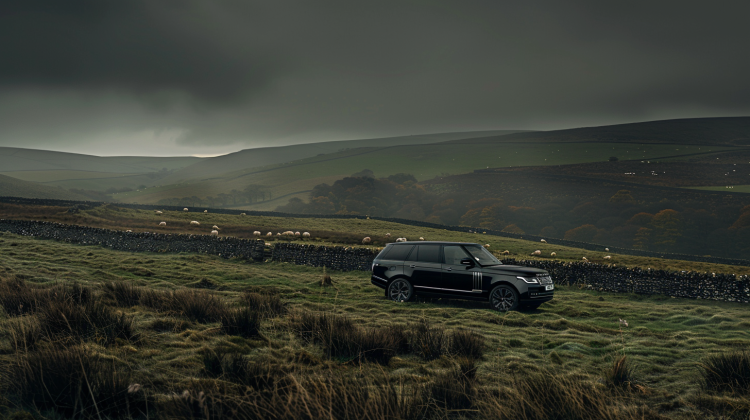
Range Rover’s production capabilities demonstrate how heritage craftsmanship integrates with modern manufacturing techniques to create vehicles that embody luxury across international markets. The brand’s strategic approach to global expansion preserves its British identity while meeting diverse consumer demands worldwide.
UK Heritage and Production Legacy
Range Rover’s manufacturing roots remain firmly planted in British soil, where the Solihull and Halewood facilities continue to produce the iconic vehicles that defined the luxury SUV segment. The Solihull plant, established in 1948, serves as the primary production center for the Range Rover, Range Rover Sport, and Velar models, maintaining the craftsmanship standards that Charles Spencer “Spen” King envisioned when he created the first prototype.
British manufacturing excellence extends beyond assembly lines to encompass the specialized skills developed over decades of automotive production. The Halewood facility produces the Range Rover Evoque and Discovery Sport, utilizing advanced aluminum body construction techniques that reduce vehicle weight while maintaining structural integrity. These UK plants employ approximately 10,000 workers who possess expertise in luxury vehicle assembly, from hand-finishing leather interiors to precision engine installation.
The production legacy connects directly to Range Rover’s brand identity as a symbol of British engineering prowess. Manufacturing processes incorporate traditional craftsmanship elements, such as hand-stitched leather seats and individually inspected wood veneers, alongside automated systems that ensure consistent quality. The UK facilities maintain ISO 9001 certification standards and implement lean manufacturing principles that minimize waste while maximizing efficiency.
Solihull’s production capacity reaches 150,000 vehicles annually, with the facility investing £500 million in modernization projects between 2020 and 2024. These investments include new paint shops equipped with advanced environmental controls and body shops featuring robotic welding systems that achieve precision tolerances within 0.1 millimeters. The combination of heritage craftsmanship and technological advancement creates vehicles that reflect both tradition and innovation.
The British production legacy influences Range Rover’s global branding strategy by reinforcing the authenticity that luxury consumers value. Each vehicle carries a “Made in Britain” designation that communicates quality and heritage, supporting premium pricing strategies across international markets. The UK manufacturing base enables Range Rover to maintain quality control standards that align with its luxury positioning while supporting approximately 40,000 jobs throughout the British automotive supply chain.
International Expansion Strategy
Range Rover’s global expansion reflects strategic market positioning that balances maintaining British heritage with meeting regional consumer preferences across diverse international markets. Since Tata Motors acquired Jaguar Land Rover in 2008, the brand has implemented a comprehensive internationalization strategy that established manufacturing presence in key growth markets while preserving core brand values.
The expansion strategy encompasses production facilities in Brazil, China, India, and Slovakia, enabling Range Rover to reduce shipping costs and respond quickly to regional market demands. The Changshu facility in China, operational since 2014, produces the Range Rover Evoque specifically for the Chinese market, which became the largest single-country market for Range Rover by 2023. This facility incorporates the same quality standards as UK plants while adapting production processes to meet local regulatory requirements.
Jaguar Land Rover’s international manufacturing network produces approximately 430,000 vehicles annually across all facilities, with Range Rover models representing 35% of total production volume. The Slovakia facility in Nitra manufactures the Land Rover Discovery, supporting European market demand while reducing transportation costs and delivery times. Each international facility maintains direct communication with UK engineering centers to ensure consistency in manufacturing processes and quality standards.
The global expansion strategy targets affluent consumers in emerging markets where luxury vehicle ownership represents social status and economic success. China accounts for 25% of global Range Rover sales, followed by the United States at 22% and the United Kingdom at 15%. The brand’s lifestyle branding approach resonates with international consumers who associate Range Rover ownership with success, adventure, and sophisticated taste.
Regional customization strategies accommodate local preferences without compromising core brand identity. Range Rover offers extended wheelbases for Chinese consumers who prefer chauffeur-driven vehicles, while maintaining standard configurations for European markets where owner-operators predominate. Marketing campaigns adapt cultural references and imagery while preserving the brand’s association with British luxury and off-road capability.
The international expansion supports Range Rover’s position as a global luxury brand while generating economies of scale that improve profitability. Local production reduces import duties and currency exchange risks, enabling competitive pricing strategies in key markets. The expansion strategy positions Range Rover to capture growth opportunities in emerging markets while maintaining its established presence in traditional luxury vehicle markets.
Digital marketing initiatives support global brand consistency by creating unified messaging across international markets. Range Rover’s social media presence reaches 12 million followers across platforms, with content tailored to regional preferences while maintaining consistent brand aesthetics. The digital strategy reinforces Range Rover’s status as a status symbol vehicle that transcends geographical boundaries while respecting local cultural values.
Corporate Evolution and Modern Ownership
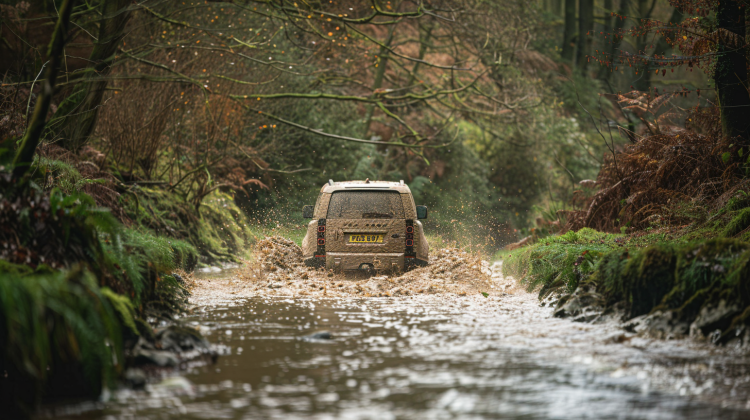
Range Rover’s corporate trajectory reflects strategic business decisions that transformed a British automotive icon into a global luxury powerhouse. The brand’s evolution through different ownership structures demonstrates how strategic acquisitions can preserve heritage while enabling international expansion.
The Tata Motors Acquisition Impact
Tata Motors’ $2.23 billion acquisition of Jaguar Land Rover in 2008 marked a pivotal transformation for Range Rover’s global positioning. This strategic purchase occurred during the global financial crisis when Ford divested non-core assets, creating an opportunity for Tata to acquire prestigious British automotive brands.
The acquisition immediately provided Range Rover with financial stability and access to emerging markets where Tata maintained established operations. Within three years of the acquisition, JLR’s revenue increased from $10.7 billion in 2009 to $15.8 billion in 2012, demonstrating the positive impact of Tata’s ownership on Range Rover’s commercial performance.
Tata’s investment strategy focused on product development and technological advancement rather than cost-cutting measures. The Indian conglomerate allocated $1.5 billion annually for research and development across JLR brands, enabling Range Rover to maintain its luxury positioning while incorporating modern technologies. This investment approach preserved Range Rover’s brand identity while enhancing its technical capabilities.
The acquisition facilitated Range Rover’s expansion into Asian markets, particularly China and India, where luxury SUV demand experienced substantial growth. Sales in China increased by 47% between 2010 and 2013 following Tata’s strategic market entry initiatives. The company established local partnerships and adapted marketing strategies to resonate with affluent Asian consumers seeking status symbol vehicles.
Tata’s ownership also enabled Range Rover to invest in sustainable technologies without compromising luxury standards. The introduction of hybrid powertrains and lightweight aluminum construction reflected Tata’s commitment to environmental responsibility while maintaining Range Rover’s performance heritage. These innovations positioned the brand favorably among environmentally conscious luxury consumers.
Jaguar Land Rover Integration
The 2013 legal consolidation under Jaguar Land Rover Automotive PLC created operational synergies that strengthened Range Rover’s global branding efforts. This integration eliminated redundancies while preserving each brand’s distinct identity, allowing Range Rover to benefit from shared resources without diluting its luxury positioning.
JLR’s integrated structure enabled Range Rover to leverage Jaguar’s expertise in luxury sedan markets while maintaining its SUV heritage. Engineering teams collaborated on platform development, reducing costs while enhancing performance capabilities across both brands. The shared Ingenium engine family exemplifies this collaboration, providing Range Rover with efficient powertrains that maintain luxury performance standards.
Manufacturing integration optimized production efficiency without compromising quality standards. Range Rover production at Solihull benefited from JLR’s standardized quality control processes, ensuring consistent build quality across global markets. The facility’s annual capacity increased to 150,000 units by 2015, meeting growing international demand while maintaining craft-based assembly techniques.
Marketing integration strengthened Range Rover’s lifestyle branding by connecting it with Jaguar’s sporting heritage and British luxury positioning. Joint marketing campaigns emphasized British automotive excellence, creating brand synergies that reinforced both marques’ premium positioning. This approach enhanced Range Rover’s appeal among luxury consumers seeking authentic British automotive heritage.
JLR’s integrated dealer network expanded Range Rover’s global presence significantly. The company established 2,800 retail locations across 170 countries by 2020, providing Range Rover with unprecedented global reach. This expansion enabled localized customer service while maintaining consistent brand presentation standards across diverse cultural markets.
The integration facilitated technology sharing that enhanced Range Rover’s advanced driver assistance systems and infotainment capabilities. JLR’s InControl Touch Pro system became standard across Range Rover models, providing seamless connectivity and navigation features that appealed to technology-focused luxury consumers. This technological consistency reinforced Range Rover’s position as a modern luxury brand.
Financial integration created economies of scale that enabled Range Rover to invest in premium materials and advanced manufacturing techniques. Shared procurement reduced component costs while maintaining quality standards, allowing greater investment in luxury interior materials and advanced suspension systems. These improvements enhanced Range Rover’s reputation for combining capability with comfort.
The consolidated structure enabled Range Rover to respond quickly to market changes and consumer preferences. During the COVID-19 pandemic, JLR’s integrated supply chain management minimized production disruptions, ensuring Range Rover maintained market availability when competitors faced extended delays. This operational resilience reinforced customer confidence in the Range Rover brand.
Brand Positioning in the Luxury Market
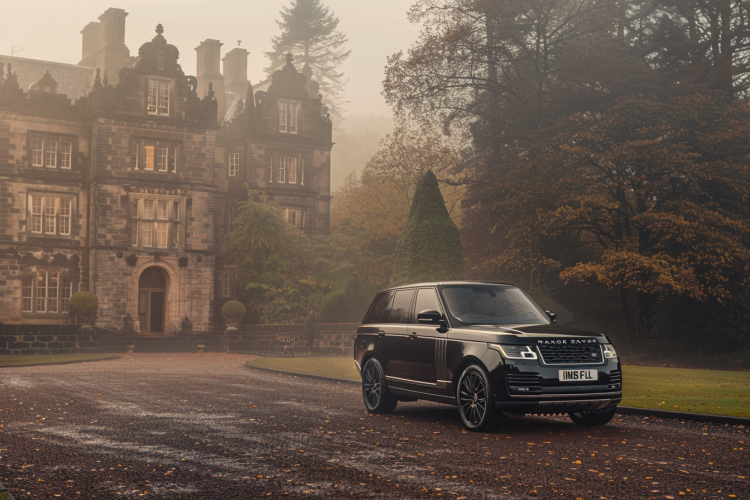
Range Rover positions itself as the pinnacle of luxury SUV excellence, masterfully balancing British heritage with contemporary sophistication. The brand commands premium pricing through strategic differentiation that emphasizes authenticity, quality, and innovation within the luxury automotive sector.
Competing with Premium Automotive Brands
Range Rover’s brand identity centers on its unique position as the original luxury SUV, a heritage that distinguishes it from traditional luxury automakers like Mercedes-Benz, BMW, and Audi. While these German brands entered the SUV market decades after Range Rover established the category in 1970, Range Rover leverages its 54-year legacy to maintain market leadership through authentic luxury car lifestyle positioning.
The brand’s automotive prestige branding strategy focuses on three core differentiators that separate it from premium competitors. First, Range Rover emphasizes genuine off-road capability alongside luxury refinement, contrasting with luxury brands that prioritize on-road performance. Second, the brand maintains British craftsmanship traditions through materials like Windsor leather and natural wood veneers, creating distinctive interior environments that reflect cultural authenticity. Third, Range Rover’s global branding emphasizes emotional connection over technical specifications, positioning vehicles as lifestyle statements rather than mere transportation.
Manufacturing excellence reinforces Range Rover’s luxury positioning through production at Jaguar Land Rover’s Solihull and Halewood facilities in the UK. This geographic authenticity supports the brand’s British heritage narrative while ensuring quality control standards that match luxury market expectations. Additional assembly locations in Slovakia and China enable global market penetration without compromising core brand values.
Range Rover’s marketing strategy targets affluent consumers who value exclusivity and authenticity over mass-market appeal. The brand deliberately limits production volumes to maintain exclusivity, with special editions like the Range Rover Fifty model restricted to 1,970 units globally. This scarcity approach contrasts with volume-focused luxury competitors, reinforcing Range Rover’s status symbol vehicles positioning.
Pricing strategy reflects Range Rover’s premium positioning, with models commanding price premiums over comparable luxury SUVs from German manufacturers. The brand justifies higher prices through superior off-road capability, British craftsmanship, and heritage authenticity that resonates with luxury consumers seeking distinctive ownership experiences.
Celebrity Endorsements and Cultural Influence
Range Rover’s cultural influence extends far beyond traditional automotive marketing through strategic associations with royalty, celebrities, and prestigious events. The British Royal Family’s long-standing preference for Land Rover and Range Rover vehicles creates powerful Range Rover Royalty Favorite associations that elevate the brand’s global status and credibility.
Royal endorsements provide unparalleled lifestyle branding opportunities that luxury competitors struggle to replicate. Queen Elizabeth II’s public appearances in Land Rover Defenders and Range Rover vehicles throughout her 70-year reign established deep cultural connections between the brand and British monarchy. This royal patronage continues with King Charles III and other royal family members, maintaining Range Rover’s elevated social positioning.
Celebrity ownership patterns reinforce Range Rover’s image as the preferred choice among entertainment industry figures, professional athletes, and business leaders. High-profile owners include musicians, actors, and sports personalities who value the brand’s combination of luxury refinement and capability versatility. These organic endorsements create authentic cultural currency that traditional advertising campaigns cannot achieve.
The brand’s presence in luxury lifestyle contexts extends beyond individual ownership to include partnerships with prestigious sporting events, luxury hotels, and exclusive clubs. Range Rover sponsors polo tournaments, equestrian events, and sailing competitions that align with affluent consumer interests and values. These associations reinforce the brand’s elite driving experience positioning within luxury lifestyle contexts.
Range Rover’s cultural influence manifests through appearances in premium television shows, films, and media productions that reinforce its status symbol vehicles image. The brand’s vehicles frequently appear in content targeting affluent demographics, creating subconscious associations between Range Rover ownership and success, sophistication, and achievement.
Social media presence amplifies Range Rover’s cultural influence through carefully curated content that showcases the brand’s luxury lifestyle positioning. The company maintains active engagement across platforms while avoiding overt promotional messaging, instead focusing on aspirational content that reinforces brand values and heritage authenticity.
The Range Rover London Collection represents the brand’s expansion into luxury lifestyle products beyond automotive manufacturing. This fashion and lifestyle capsule collection, developed under Chief Creative Officer Gerry McGovern’s direction, extends Range Rover’s brand influence into complementary luxury categories while maintaining design consistency and British craftsmanship standards.
Cultural influence metrics demonstrate Range Rover’s successful positioning within luxury market segments. Brand recognition studies consistently rank Range Rover among the most desirable luxury automotive brands globally, with particularly strong performance in markets where British heritage and royal associations carry cultural significance.
Innovation Legacy and Future Vision
Range Rover’s innovation legacy spans technological breakthroughs that transformed the luxury SUV sector while establishing automotive benchmarks. The brand’s commitment to advancing both capability and refinement continues shaping its strategic direction toward sustainable mobility solutions.
Technological Milestones Over Five Decades
Range Rover introduced permanent four-wheel drive systems in 1970, creating the foundation for modern all-terrain capability. This technology combined with coil spring suspension delivered superior ride quality compared to leaf-spring alternatives used by competitors. The system provided continuous power distribution to all wheels, eliminating the need for manual engagement typical in utility vehicles of that era.
Electronic air suspension emerged as a defining feature in subsequent decades, allowing drivers to adjust ride height for different terrain conditions. The system automatically leveled the vehicle while providing enhanced comfort on paved surfaces and increased ground clearance for off-road adventures. Advanced terrain response systems followed, enabling optimized traction control across sand, snow, mud, and rock surfaces through automated drivetrain adjustments.
Driver assistance technologies became integral to Range Rover’s luxury positioning during the 2000s. Adaptive cruise control, lane departure warning, and blind spot monitoring enhanced safety while maintaining the premium driving experience. These systems integrated seamlessly with the vehicle’s existing electronic architecture without compromising off-road functionality.
The introduction of lightweight aluminum construction represented a significant engineering advancement, reducing vehicle weight by approximately 420 kilograms while maintaining structural integrity. This aluminum-intensive architecture improved fuel efficiency and handling dynamics without sacrificing the robustness required for challenging terrain. Advanced manufacturing techniques enabled precise construction tolerances that enhanced both performance and durability.
Infotainment systems evolved from basic radio units to sophisticated multimedia platforms featuring touchscreen interfaces, smartphone integration, and real-time navigation. The latest systems incorporate artificial intelligence for predictive maintenance alerts and personalized driver preferences. These technological integrations support Range Rover’s lifestyle branding by connecting occupants to their digital environments while maintaining focus on the driving experience.
Sustainability and Electric Future
Jaguar Land Rover committed to achieving carbon neutrality across its supply chain and operations by 2039, positioning Range Rover at the forefront of sustainable luxury mobility. This commitment includes transitioning the entire Range Rover lineup to electric and hybrid powertrains before 2030, maintaining performance capabilities while reducing environmental impact.
Electric Range Rover models retain the brand’s signature off-road prowess through advanced battery placement and thermal management systems. The electric architecture preserves wading depth capabilities up to 850 millimeters while delivering instant torque for enhanced traction in challenging conditions. Battery technology developments focus on extended range capabilities that support long-distance travel without compromising the luxury experience Range Rover customers expect.
Sustainable materials integration extends beyond powertrains to interior appointments and manufacturing processes. Range Rover incorporates recycled aluminum, sustainable leather alternatives, and responsibly sourced wood veneers throughout its vehicle lineup. These materials maintain the premium aesthetic while reducing environmental footprint through circular economy principles.
Manufacturing facilities implement renewable energy sources and waste reduction programs that align with the brand’s sustainability objectives. The Solihull plant utilizes solar power and energy-efficient production methods that reduce carbon emissions per vehicle by 18% compared to previous manufacturing processes. Water recycling systems and waste-to-energy programs further minimize environmental impact during production.
The brand’s electric future strategy encompasses charging infrastructure partnerships and battery recycling programs that support customer adoption of electrified vehicles. Range Rover collaborates with charging network providers to ensure access to rapid charging stations in urban and remote locations. Battery lifecycle management programs recover valuable materials from end-of-life batteries, supporting sustainable resource utilization while maintaining the exclusivity associated with Range Rover ownership.
Range Rover’s innovation trajectory demonstrates how traditional luxury automotive brands adapt to evolving consumer expectations while preserving core brand attributes. The integration of electric powertrains with proven off-road capability positions Range Rover to maintain its status symbol vehicles recognition in an electrified automotive environment. This strategic approach ensures the brand’s continued relevance among affluent consumers seeking both environmental responsibility and uncompromised luxury performance.
Conclusion
Range Rover’s global branding heritage represents one of the automotive industry’s most successful luxury positioning strategies. The brand’s ability to maintain its core identity while adapting to modern consumer demands demonstrates exceptional brand management across multiple ownership transitions.
Today’s Range Rover continues to embody the original vision of combining rugged capability with sophisticated luxury. This unique positioning has allowed the brand to transcend traditional automotive boundaries and establish itself as a lifestyle symbol that resonates with affluent consumers worldwide.
The commitment to innovation and sustainability ensures Range Rover’s relevance in an evolving automotive landscape. As the brand moves toward electrification while preserving its heritage values it reinforces its status as the definitive luxury SUV that others continue to emulate.
Frequently Asked Questions
What is the historical significance of the Range Rover?
The Range Rover revolutionized the automotive industry by creating the luxury SUV category over 50 years ago. Launched in 1970 by British Leyland, it was the first vehicle to successfully combine rugged off-road capability with on-road comfort and luxury. Its cultural impact was so significant that it became the first car ever displayed at the Louvre, cementing its status as a design icon.
Who created the original Range Rover concept?
Charles Spencer “Spen” King developed the Range Rover concept in the late 1960s. His vision was to bridge the gap between rugged Land Rovers and comfortable passenger cars, creating a vehicle that could handle diverse terrains while providing luxury and comfort. The prototype underwent extensive testing across various environments to establish the vehicle’s unique brand identity.
What makes Range Rover different from other luxury SUVs?
Range Rover differentiates itself through its 54-year legacy as the original luxury SUV, combining British heritage with contemporary sophistication. Unlike competitors like Mercedes-Benz and BMW, Range Rover offers unique features like the Terrain Response system, advanced four-wheel drive technology, and a design philosophy that balances rugged capability with refined luxury, creating a comprehensive lifestyle brand.
Who owns Range Rover today?
Range Rover is currently owned by Tata Motors through its Jaguar Land Rover subsidiary. Tata Motors acquired Jaguar Land Rover in 2008, which marked a pivotal transformation for the brand’s global positioning. This acquisition provided financial stability, access to emerging markets, and investment in product development and technological advancement.
What innovations has Range Rover introduced to the automotive industry?
Range Rover pioneered several automotive innovations including permanent four-wheel drive systems, coil spring suspension, electronic air suspension, and advanced driver assistance technologies. The brand continues to innovate with lightweight aluminum architecture, sustainable luxury materials, and hybrid/electric powertrains as part of Jaguar Land Rover’s commitment to achieving carbon neutrality by 2039.
What is Range Rover’s target market?
Range Rover targets affluent consumers who seek both luxury and versatility in their vehicles. The brand appeals to buyers who value exclusivity, authenticity, and British heritage. Marketing strategies emphasize limited production volumes to maintain luxury status, with celebrity endorsements and royal family associations enhancing the brand’s prestige and cultural influence.
How has Range Rover maintained its luxury status over the decades?
Range Rover maintains its luxury status through consistent quality, attention to detail, and limited production numbers that ensure exclusivity. The brand balances tradition with innovation, incorporating modern technologies while preserving its original design philosophy. Strategic positioning in luxury lifestyle contexts, elite event sponsorships, and cultural associations reinforce its status as a symbol of success and sophistication.
What is Range Rover’s approach to sustainability?
Range Rover is committed to environmental responsibility through Jaguar Land Rover’s goal of achieving carbon neutrality by 2039. The brand is transitioning to electric and hybrid powertrains, integrating sustainable materials in manufacturing, and utilizing renewable energy in production processes. This approach aligns with evolving consumer expectations while maintaining the brand’s luxury positioning.
Valencia Jackson serves as Global Senior Director of Strategic Brand Strategy and Communications at AMW, where she specializes in brand development and audience engagement strategies. With her deep understanding of market trends and consumer behavior, Valencia helps clients craft authentic narratives that drive measurable business results. Her strategic methodology focuses on building sustainable client relationships through data-driven insights, creative innovation, and unwavering commitment to excellence.

